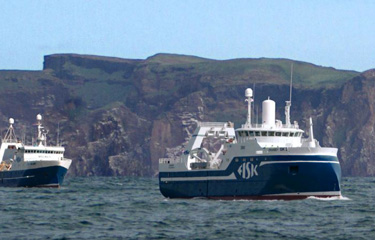Iceland Seafood International (ISI) reported a 14 percent uptick in sales in the first half of 2022, but that wasn’t enough to overcome higher operating costs, as the Reykjavik, Iceland-headquartered seafood company posted a normalized loss before tax of EUR 1.8 million (USD 1.8 million) in H1 2022.
While its total sales in H1 2022 reached EUR 238.4 million (USD 238 million), its bottom-line loss of EUR 2.9 million (USD 2.4 million) reversed a profit of EUR 3.4 million (USD 3.4 million) in H1 2021.
“The first half of the year has been a disappointment for Iceland Seafood,” ISI CEO Bjarni Ármannsson said.
Ármannsson said during the COVID crisis, ISI emphasized rebalancing its business through more retail exposure, but that shift has made it harder to pass through higher input costs to customers in the retail sector.
“It is like chasing your own tail,” Ármannsson said. “This has left us with a higher cost base, which than results in a negative bottom line. We are now experiencing slower demand as prices have increased, which then is reflected in lower raw material prices as demand side softens.”
Whitefish prices of all origins have increased significantly, with cod prices rising by 25 percent over the first six months of 2022, and salmon prices reaching a historically high level in May, up 90 percent from the start of the year, Ármannsson said. ISI’s operations in Ireland and at subsidiary Ahumados Domínguez, a Spanish seafood processor ISI purchased in May 2021, were especially impacted by these increases, Ármannsson said.
However, salmon prices have now leveled off at the same time as price increases have been passed on to customers, which Ármannsson said would bring profitability at ISI’s Irish operations and at Ahumados Domíngues back to normal levels from the third quarter of 2022.
ISI’s H1 2022 sales within its Value-Added Southern Europe division amounted to EUR 108.8 million (USD 108.6 million), up 27 percent year-on-year, due largely to price increases. Demand for its cod products was strong in the period and market conditions for its Argentinean shrimp was stable, though production of Argentinian shrimp at ISI subsidiary Achernar was 30 percent down 30 percent by volume over H1 2021.
Additionally, Iceland Seafood’s U.K. operations were loss-making in the period, with external challenges continuing to impact the business, Ármannsson confirmed. He said “it has become clear” that it will take longer and cost more than previously estimated to stabilize the firm’s U.K. operations, despite the hiring of former Hilton Seafood Production Director Glen Mathews who was appointed managing director of ISI's U.K. operations in February 2021.
“On top of negative impact of cost increases during H1 2022, the outbreak of omicron COVID-19 had a disruptive impact on both operations and logistics in the beginning of the year,” Ármannsson said.
Further complication ISI’s U.K. operations was a fire that broke out 25 August along a coating line at the company’s Grimsby, U.K. plant.
The company estimates its U.K. operations will continue to be loss-making through 2022, but will break even in H1 2023. Ármannsson said the U.K. division must push to realign sales prices with market conditions and to grow the business with both current and new customers.
"Firstly, and most importantly, all of our employees were safely evacuated from the building with no reported injuries. The Humberside Fire & Rescue Service attended the site and quickly extinguished the flames. The fire was isolated and contained within a single fryer room. Damage was limited to the area around the fryer and detailed investigations are currently ongoing,” Mathews said in a statement. “We have informed our customers of the situation but due to the containment of the fire, the incident will have minimal impact on our service. I am proud of the professional and calm manner of the operational team on site who swiftly dealt with the incident. They demonstrated their commitment and passion for the business in the most difficult of circumstances."
Elsewhere in the company, ISI’s Sales and Distribution division performed well in the six-month period, driven by strong demand for Icelandic products, according to Ármannsson. Divisional sales of EUR 87 million (USD 86.9 million) were up EUR 10.2 million (USD 10.2 million), despite the closure of the firm’s U.S. sales division at the end of 2021. Growth was driven by significant price increases in the period, while the volume of groundfish and pelagic sales were down 9 percent and 22 percent, respectively. Continuing supply chain disruptions and global tariffs and sanctions on Russian products are having positive impact on demand for Icelandic products both in Europe and the United States, the company said.
ISI’s outlook range for its 2022 normalized profit before tax has been revised to EUR 9 million to EUR 14 million (USD 9 million to USD 14 million), with most of the profit expected to be generated in the Q4 2022.
“We are more optimistic for the second half [of 2022], as we see input prices of raw material stabilize or on a downward trend. We firmly believe that we have a strong position in our markets and that we will be able to make the most of that position for the upcoming months,” Ármannsson said.
Photo courtesy of ISI







